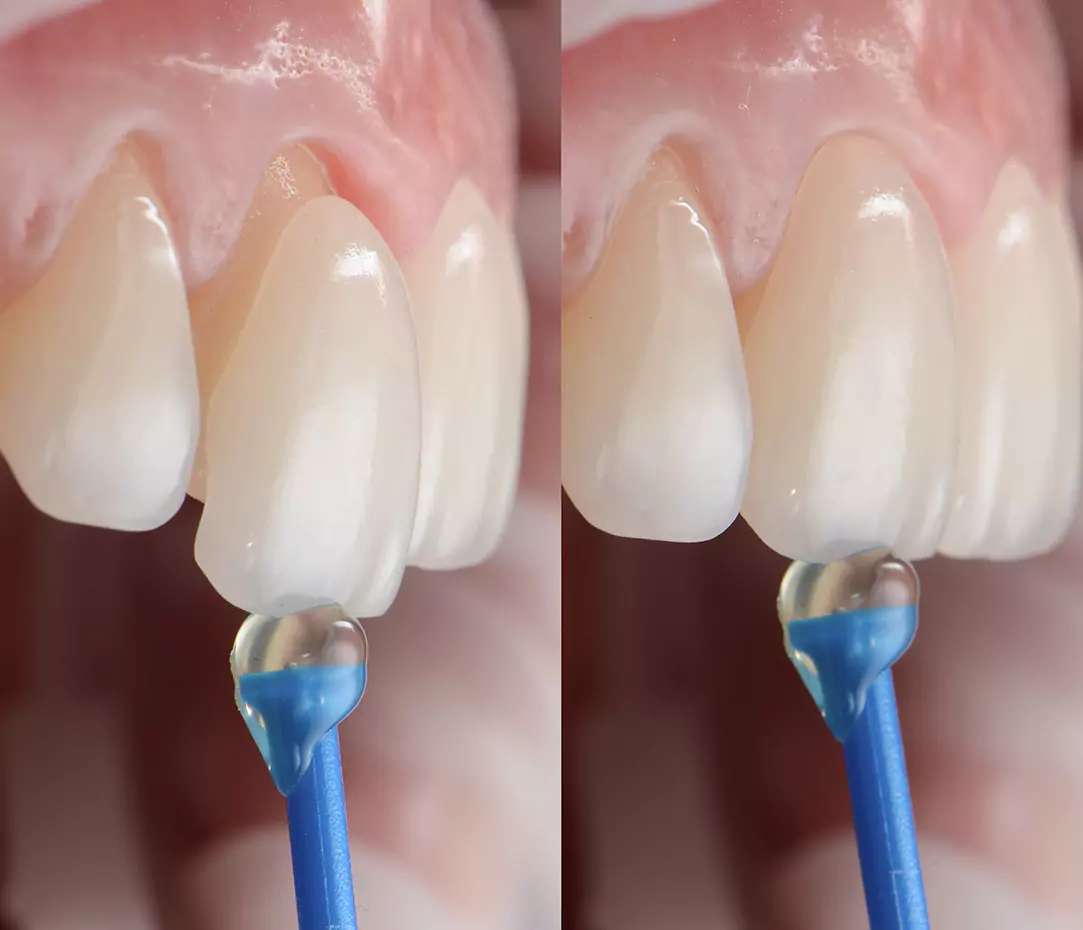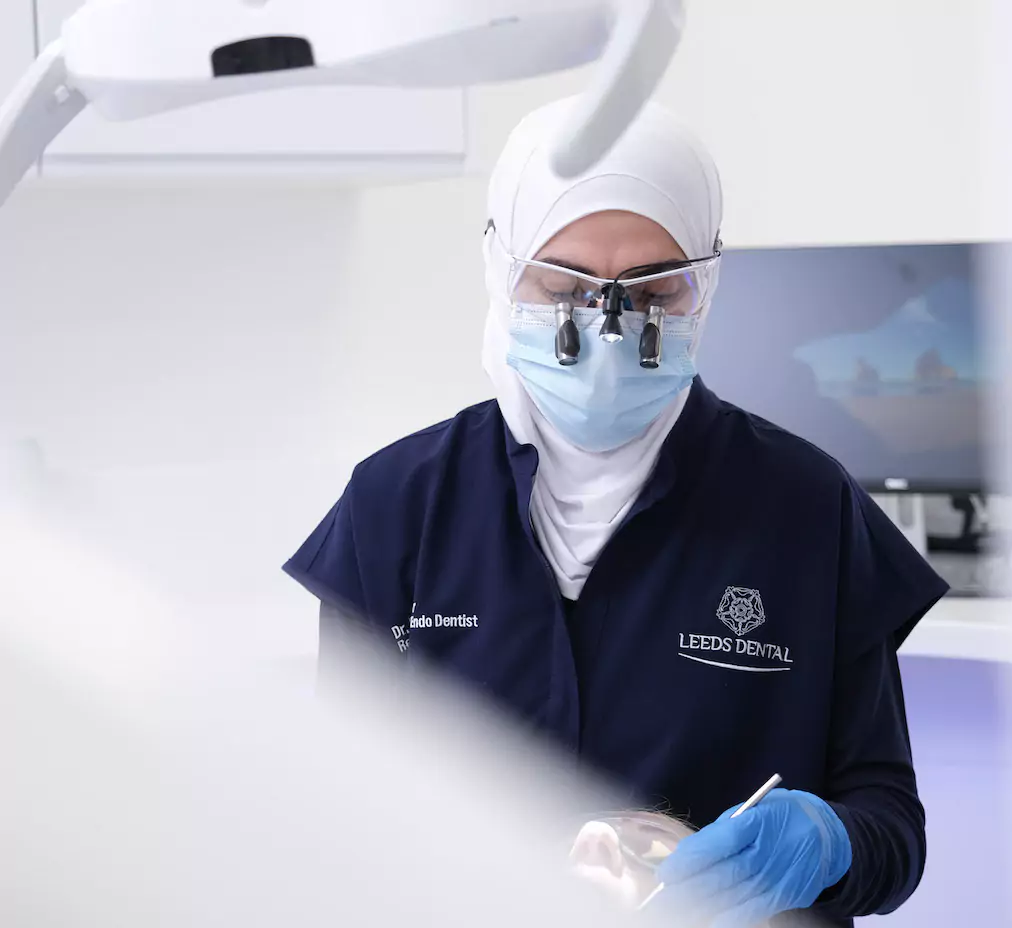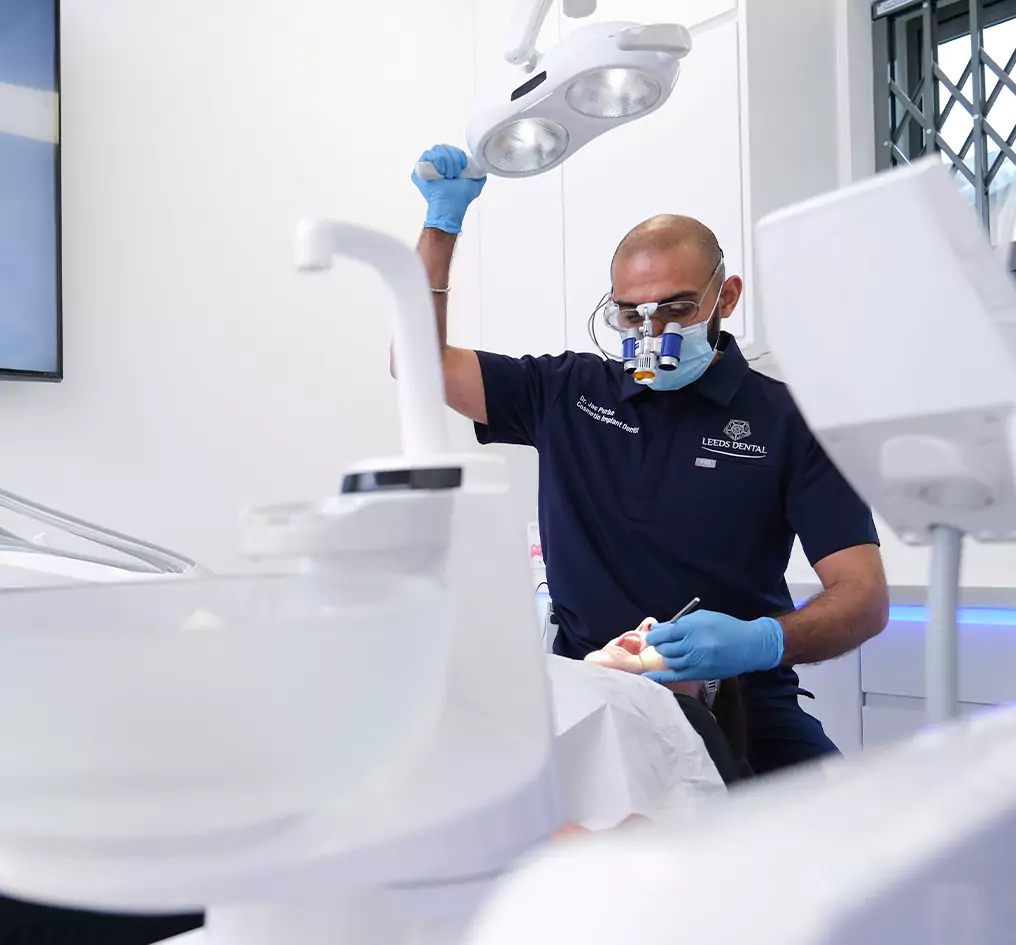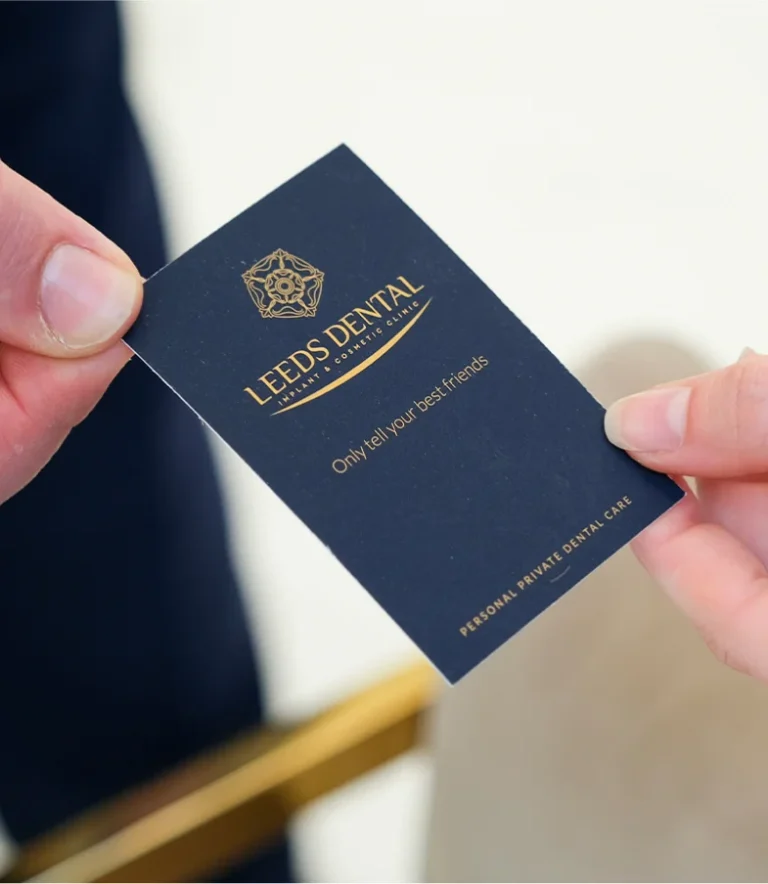Repairing cracked or chipped teeth
PORCELAIN VENEERS LEEDS
Helping Revitalise Your
BRIGHT
CONFIDENT SMILE
Stained, misshapen, and damaged teeth can drain your confidence. And when your self-esteem is diminished by a catalogue of minor defects, the problems don’t feel so small.
Dental veneers are a fine porcelain coating that can be applied to your teeth to correct these problems. This simple but highly effective treatment is a fantastic way to restore your smile and rebuild lost confidence.
The choice of many A-list celebrities, veneers aren’t just an effective cosmetic solution for improving the appearance of your teeth—they also protect them from further damage.


THE VENEER PLACEMENT PROCESS
Successful veneer placement relies on an in-depth assessment of your needs and the current condition of your teeth and a process refined through years of clinical practice.
The veneer placement process begins with a consultation. During this initial appointment, we’ll assess your suitability for the procedure and discuss the issues with your smile that you’d like to address.
Using the latest technology, we’ll analyse your teeth and, using information from our state-of-the-art planning software, our laboratory will craft smile-enhancing bespoke veneers. Before making your veneers, we can select the perfect colour for the porcelain that is guaranteed to brighten your teeth.
Once your veneers are ready for placement, we’ll prepare you by giving you a local anaesthetic. This will numb the area where we’ll be positioning the veneers so that the process will be as pain and discomfort free as possible.
To ensure your veneers fit perfectly, we’ll remove a portion of your tooth’s enamel. Next, we’ll position the veneer and bond it into place once we’re happy with its appearance.

THE BENEFITS OF VENEERS
There are many issues that veneers can help with, including:

FOR LEEDS DENTAL IMPLANT AND COSMETIC CLINIC
PORCELAIN VENEERS - Frequently Asked Questions
What are porcelain veneers and what dental concerns can they address?
Porcelain veneers are ultra-thin, custom-made shells of high-quality ceramic material that are bonded to the front surface of your teeth. These elegant restorations are designed to enhance your smile by improving the appearance of your teeth while providing protection and strength. Favoured by many celebrities, veneers offer a remarkable way to transform your smile with minimal intervention.
Understanding Porcelain Veneer Restorations
Porcelain veneers are crafted from advanced dental ceramics that mimic the natural translucency and light-reflecting properties of tooth enamel. Each veneer is individually designed to complement your facial features and create a naturally beautiful smile. The porcelain material is carefully shaped and coloured to blend seamlessly with your existing teeth or to create your desired aesthetic improvement.
The Structure and Properties of Dental Veneers
Though remarkably thin—typically between 0.3mm and 0.7mm in thickness—porcelain veneers offer impressive durability thanks to their advanced ceramic composition. The porcelain material resists staining far better than natural tooth enamel, helping to maintain a bright smile for years. The veneer’s surface is glazed to create a realistic sheen that mimics the natural lustre of healthy teeth, making them virtually indistinguishable from natural teeth.
How Veneers Integrate with Dental Anatomy
Veneers are bonded to the front surface of your teeth using specialised dental adhesives that create an incredibly strong attachment. This bond allows the thin porcelain shell to become essentially part of your tooth, moving and functioning with it naturally. The margins of well-designed veneers sit just at or slightly below the gumline, creating a smooth transition between the restoration and your natural tooth structure.
Dental Concerns Addressed by Porcelain Veneers
Porcelain veneers are incredibly versatile cosmetic restorations that can resolve multiple aesthetic concerns simultaneously, making them an efficient solution for comprehensive smile enhancement.
Aesthetic Improvements Through Veneer Placement
Veneers excel at addressing a wide range of cosmetic dental issues. They can effectively conceal permanent stains and discolouration that resist professional whitening treatments, including tetracycline staining or discolouration from root canal therapy. Veneers are also ideal for repairing chipped or worn teeth, closing small gaps between teeth (diastema), and correcting minor misalignment or rotation without the need for orthodontic treatment.
Structural Benefits for Compromised Teeth
Beyond their aesthetic advantages, veneers provide protective benefits for teeth with minor structural concerns. They can strengthen teeth with cracked or eroded enamel by providing an additional protective layer against further damage. For teeth with minor fractures or wear from grinding (bruxism), veneers can restore the original contour and protect the underlying tooth structure from further deterioration.
Smile Design with Custom Veneers
Perhaps one of the most significant benefits of porcelain veneers is their ability to completely transform your smile’s appearance. Through careful design of the shape, size, colour, and alignment of each veneer, your dentist can create a harmonious smile that complements your facial features and enhances your overall appearance. This complete smile makeover approach can address multiple concerns simultaneously for a dramatic improvement.
Every smile is unique, and your dentist will help determine if porcelain veneers are the right solution for your specific dental concerns. A thorough consultation will assess your dental health, aesthetic goals, and functional needs to create a personalised treatment plan for your veneer restoration.
How is the porcelain veneer procedure carried out and what does it involve?
The journey to a revitalised smile with porcelain veneers involves several carefully planned steps, combining the artistic skill of your dentist with advanced dental technology. This refined process ensures your veneers will look completely natural while providing the aesthetic improvements you desire.
Initial Consultation for Veneer Treatment
Your veneer journey begins with a comprehensive consultation where your dentist will evaluate your dental health and discuss your smile goals. This important first step allows your dentist to understand your expectations and determine if veneers are the most appropriate solution for your specific needs.
Smile Analysis and Treatment Planning
During this initial assessment, your dentist will carefully examine your teeth, gums, and bite relationship. Digital photographs and possibly X-rays will be taken to provide detailed information about your dental structures. Using advanced planning software, your dentist can analyse various aspects of your smile, including tooth proportions, gum contours, and facial symmetry to develop a customised treatment plan.
Shade Selection and Design Preview
An important part of the planning process involves selecting the ideal shade for your veneers. Your dentist will consider factors such as your skin tone, facial features, and existing teeth to recommend the most flattering colour. Many practices now offer digital smile design technology that can create a preview of how your veneers will look, allowing you to visualise the expected results before treatment begins.
The Porcelain Veneer Preparation Process
Once your treatment plan is finalised, the next step involves preparing your teeth to receive the veneers. This stage creates the foundation for successful veneer placement and ensures optimal aesthetics and function.
Conservative Tooth Preparation
To create space for the veneers and ensure they fit naturally, your dentist will gently reshape the front surface of your teeth. This typically involves removing a small amount of enamel—usually between 0.3mm and 0.7mm, depending on your specific situation and the type of veneers selected. Local anaesthetic is used during this step to ensure your comfort throughout the procedure. The preparation is precisely controlled to preserve as much healthy tooth structure as possible while creating the ideal foundation for your veneers.
Impression Taking and Temporary Veneers
After preparation, detailed impressions or digital scans of your teeth are taken to create an exact model of your mouth. These impressions capture every detail of your prepared teeth and surrounding structures, providing the laboratory technicians with the information needed to craft your custom veneers. If significant enamel has been removed, temporary veneers may be placed to protect your teeth and maintain your appearance while your permanent veneers are being fabricated.
Custom Fabrication and Placement of Porcelain Veneers
The final stages of your veneer journey involve the meticulous creation and precise placement of your permanent restorations.
Laboratory Artistry in Veneer Creation
Skilled dental technicians in a specialised laboratory use your impressions and your dentist’s detailed specifications to handcraft your porcelain veneers. This artisanal process involves layering high-quality ceramic materials to create the ideal depth of colour, translucency, and characteristics that mimic natural teeth. Each veneer is individually shaped and contoured to match the agreed design and to fit perfectly with your dental anatomy.
Final Bonding and Aesthetic Refinement
When your custom veneers are ready, you’ll return for your placement appointment. Your dentist will temporarily place each veneer to check the fit and appearance before final bonding. Once you and your dentist are satisfied with how they look, the inner surface of each veneer is treated with a special etching solution and bonding agent, while your teeth are conditioned to create the strongest possible adhesion. Using light-activated dental cement, the veneers are precisely positioned and permanently bonded to your teeth. Final adjustments to shape and polish create a seamless result that feels comfortable and looks completely natural.
The entire veneer process typically requires 2-3 appointments spaced over a few weeks. Your dentist will provide specific guidance about what to expect at each stage based on your individual treatment plan, ensuring you feel informed and comfortable throughout your smile transformation journey.
Why choose porcelain veneers over other cosmetic dental treatments?
When exploring options for enhancing your smile, porcelain veneers offer several distinct advantages that set them apart from other cosmetic dental treatments. Understanding these benefits can help you determine if veneers are the right choice for achieving your desired smile transformation.
Comprehensive Aesthetic Benefits of Porcelain Veneers
One of the most compelling reasons to choose porcelain veneers is their ability to address multiple cosmetic concerns simultaneously, offering a complete smile makeover with a single treatment approach.
Versatility in Aesthetic Correction
Unlike treatments that target specific issues, such as whitening for discolouration or bonding for minor chips, porcelain veneers can resolve numerous aesthetic concerns at once. They can simultaneously correct shape irregularities, permanent staining, minor alignment issues, and small gaps between teeth. This comprehensive approach means you can achieve dramatic improvements in your smile’s appearance without undergoing multiple procedures or treatments.
Superior Colour Stability and Stain Resistance
Porcelain veneers maintain their beautiful appearance far longer than many alternative treatments. The high-quality ceramic material used in modern veneers is highly resistant to staining from coffee, tea, red wine, and tobacco—substances that readily discolour natural teeth and composite bonding. This remarkable stain resistance means your veneer restorations will maintain their bright, fresh appearance for many years, even with regular consumption of potentially staining foods and beverages.
Durability and Longevity of Veneer Restorations
The investment value of porcelain veneers becomes particularly apparent when considering their exceptional durability and longevity compared to alternative cosmetic options.
Extended Lifespan of Porcelain Restorations
With proper care, porcelain veneers typically last 10-15 years or even longer, significantly outperforming alternatives like composite bonding, which usually requires replacement every 3-7 years. This longevity makes veneers a cost-effective solution over time, despite their higher initial investment. Their resistance to chipping and wear also contributes to their extended lifespan, making them ideal for patients seeking a long-term solution for their smile concerns.
Strength and Protection for Natural Tooth Structure
Beyond their aesthetic qualities, porcelain veneers provide protective benefits for your natural teeth. The strong ceramic material and robust bonding system create a protective shield over your tooth enamel, preventing further wear or damage to teeth with minor fractures or erosion. This protective quality is particularly valuable for teeth that have been weakened by extensive wear, acid erosion, or small fractures that might otherwise worsen over time.
Natural Aesthetic Results with Porcelain Veneers
The aesthetic quality of porcelain veneers is often unmatched by other cosmetic dental treatments, creating results that are indistinguishable from natural, healthy teeth.
Light-Reflecting Properties and Translucency
Advanced dental ceramics used in modern veneers possess remarkable optical properties that mimic natural tooth enamel. Their translucency allows light to penetrate and reflect from within, just as it does with natural teeth, avoiding the flat, opaque appearance that can occur with other materials. This natural light interaction is particularly important for front teeth, where aesthetic considerations are paramount.
Customised Shape and Proportion
Porcelain veneers offer unparalleled control over the final aesthetic outcome of your smile makeover. Each veneer is individually crafted to achieve ideal tooth proportions, optimal symmetry, and harmonious alignment within your smile. This level of customisation allows your dentist to create a smile that complements your facial features and reflects your personal aesthetic preferences, whether you desire a naturally perfect look or a more dramatically enhanced appearance.
When comparing treatment options, it’s important to consider your specific dental needs, aesthetic goals, and lifestyle factors. While porcelain veneers offer remarkable benefits for many patients, your dentist will help you evaluate all available options to determine the most appropriate treatment approach for your unique situation.
Who is a suitable candidate for porcelain veneers and are there any limitations?
Porcelain veneers can transform many smiles, but they aren’t the ideal solution for everyone. Understanding whether you’re a good candidate for this treatment involves considering several factors related to your oral health, lifestyle, and aesthetic goals.
Ideal Candidates for Porcelain Veneer Treatment
Suitable candidates for veneers typically share certain characteristics that make them more likely to achieve successful, long-lasting results with this cosmetic treatment.
Healthy Dental Foundation Requirements
The best candidates for porcelain veneers have generally good oral health with minimal decay and healthy gum tissue. Your teeth should have sufficient healthy enamel to support the veneer preparation and bonding process. Any existing dental problems such as active tooth decay, gum disease (periodontal disease), or defective fillings need to be addressed before proceeding with veneer treatment to ensure a solid foundation for your new restorations.
Aesthetic Concerns That Respond Well to Veneers
Porcelain veneers are particularly well-suited for addressing certain cosmetic issues. They provide excellent results for teeth with permanent discolouration that doesn’t respond to professional whitening, including tetracycline staining or discolouration from root canal treatment. Veneers are also ideal for correcting minor misalignment, closing small gaps, repairing chipped or worn teeth, and creating a more harmonious smile by improving tooth shape and proportion.
Limitations and Considerations for Veneer Placement
While veneers offer remarkable benefits, there are situations where they might not be the most appropriate treatment option. Being aware of these limitations helps set realistic expectations.
Dental Health Contraindications
Patients with significant structural tooth damage, extensive decay, or advanced gum disease may not be suitable candidates for veneers until these conditions are addressed. Similarly, those with severely misaligned teeth or significant bite problems (malocclusion) may require orthodontic treatment before considering veneers. Insufficient enamel to support preparation or a history of extensive tooth grinding (bruxism) without proper management may also present challenges for successful veneer treatment.
Lifestyle Factors Affecting Veneer Suitability
Certain habits and lifestyle factors can impact the longevity and success of veneer treatment. Patients who clench or grind their teeth heavily may put excessive force on veneers, potentially leading to damage without appropriate protective measures such as a night guard. Those with habits like nail-biting, opening packages with teeth, or chewing on hard objects like ice or pens might also risk damaging their veneers and may need to modify these behaviours for optimal long-term results.
Alternative Treatments When Veneers Aren’t Ideal
When porcelain veneers aren’t the most suitable option, several alternative treatments can address similar concerns through different approaches.
Conservative Alternative Options
For patients with minor cosmetic issues who prefer a more conservative approach, treatments like professional teeth whitening can effectively address mild to moderate discolouration without altering tooth structure. Composite bonding offers another minimally invasive option for repairing small chips or closing minor gaps, though it typically doesn’t provide the same longevity or stain resistance as porcelain veneers.
Comprehensive Restorative Alternatives
When dental concerns extend beyond cosmetics to include significant structural issues, more comprehensive treatments might be recommended. Dental crowns provide full coverage for severely damaged or weakened teeth, while orthodontic treatments like Invisalign can address more significant alignment problems. In some cases, a combination of treatments might deliver the best results for complex dental situations.
A thorough consultation with your dentist is essential to determine if porcelain veneers are right for you. This evaluation will consider your oral health status, aesthetic goals, lifestyle factors, and personal preferences to create a treatment plan that delivers the best possible outcome for your unique situation.
How do I care for my veneers and ensure they stay in good condition long-term?
With proper care and attention, your porcelain veneers can maintain their beautiful appearance and structural integrity for many years. Following these maintenance guidelines will help protect your investment and ensure your enhanced smile continues to look its best.
Daily Maintenance for Porcelain Veneers
While porcelain veneers are highly durable, they still require consistent care to preserve their appearance and longevity. Fortunately, maintaining veneers involves many of the same practices that keep your natural teeth healthy.
Effective Oral Hygiene Practices
Brush your teeth at least twice daily using a soft-bristled toothbrush and non-abrasive toothpaste. Abrasive whitening toothpastes can gradually dull the surface of your veneers, so it’s best to choose a gentle formula specifically suitable for veneers. Pay special attention to the margin where your veneer meets your natural tooth at the gumline, as this junction can collect plaque and potentially lead to decay of the underlying tooth structure if not kept clean.
Interdental Cleaning Techniques
Daily flossing remains essential for maintaining the health of your gums around your veneered teeth. Use a gentle technique, carefully sliding the floss between teeth rather than snapping it down, which could potentially damage veneer edges. Interdental brushes or water flossers can be particularly useful for cleaning around veneer margins without applying excessive pressure that might affect the bonding over time.
Protective Measures for Veneer Longevity
Beyond regular cleaning, certain protective strategies can significantly extend the life of your veneers and help prevent damage that might compromise their appearance or function.
Bite Protection and Parafunctional Habits
If you clench or grind your teeth (bruxism), particularly during sleep, it’s advisable to wear a custom-made night guard to protect your veneers from excessive forces. These protective appliances distribute pressure evenly and create a barrier between your upper and lower teeth, preventing damage to your veneers. Similarly, avoid using your teeth as tools to open packages or bite fingernails, as these habits can place stress on veneer edges and potentially cause chipping.
Dietary Considerations for Veneer Preservation
While porcelain veneers are highly resistant to staining, the bonding materials and your natural teeth at the margins can still discolour over time. Moderation with intensely pigmented foods and beverages like coffee, tea, red wine, and berries can help maintain consistent colour. If you do enjoy these items, rinsing with water afterwards can help minimize potential staining. Also be cautious with extremely hard foods like ice, boiled sweets, or nuts, which could potentially damage veneers if bitten directly.
Professional Care for Veneer Maintenance
Regular professional care plays an essential role in maintaining your veneers and monitoring your overall oral health.
Routine Dental Examinations
Attend regular check-ups with your dentist, typically every six months, to monitor the condition of your veneers and the health of your underlying teeth and gums. Your dentist can identify and address any minor issues before they develop into problems that might compromise your restorations. These visits also allow for assessment of your bite relationship to ensure your veneers aren’t experiencing excessive pressure.
Professional Cleaning Protocols
Professional hygiene appointments help maintain gum health around your veneers and remove any tartar buildup that might affect the appearance of your smile. Be sure to inform your dental hygienist that you have porcelain veneers so they can use appropriate instruments and polishing agents that won’t scratch or damage your restorations. Some practices offer specialised maintenance visits for veneer patients to provide gentle yet effective cleaning.
With consistent home care, appropriate protective measures, and regular professional maintenance, your porcelain veneers can continue to enhance your smile for many years. If you notice any changes in your veneers, such as chips or roughness at the edges, contact your dentist promptly for assessment and advice on whether repairs might be beneficial.
VENEERS AT LEEDS DENTAL CLINIC
If you’re looking for a way to restore and revitalise your smile, veneers are a simple way of achieving several goals. Book your appointment today to find out whether veneers are the right choice for you.
